Bringing In The New Year, Greek Style
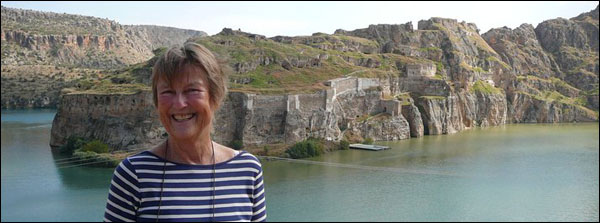
“For twelve hours we left the ‘crisis’ behind, and revisited the Greece we used to take for granted.”—Diana Farr Louis
Eating Well Is The Best Revenge
By Diana Farr Louis
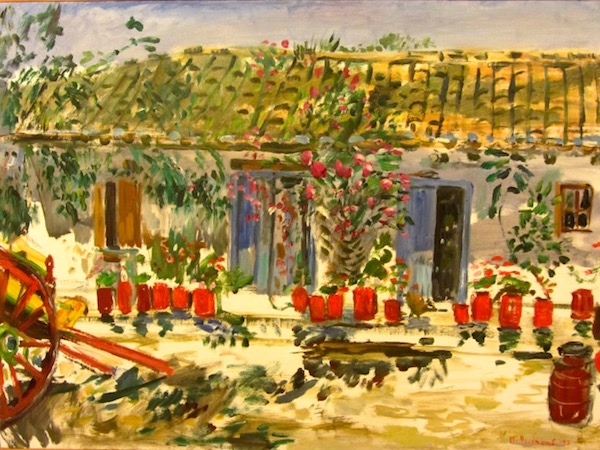
ATHENS Greece—(Weekly Hubris)—1/25/2016—After the fireworks and bubbly on the Eve and the special family lunch on the Day, January 2nd can be a slide into the slough of despond. What is there to look forward to before we revert back to daily life as usual, the same old same old routine? No papers to read, nothing but kiddie specials on the tube, no wish to start cooking again, no V8 in the fridge for our Bloody Mary, and a wrap-around greyness that discourages setting off for a beach picnic.
But this year’s second day broke the mold and, let’s hope, will start a trend for the future. We did something we’ve never done before: piled into the car of a new friend and drove to a place that has hitherto simply been a name on a map without a shred of allure. Unless you had good reason, you wouldn’t dream of setting off for Aigio, a town of shoe-box apartment buildings on the north coast of the Peloponnese. It had been aeons since we’d gone anywhere in that direction, since the so-called Patras-Corinth highway, which has been “under reconstruction” since the start of this century, still resembles a slalom ski run and is very disagreeable if not dangerous.
Reason we had, however. As Gogo had been telling me for some months, her birthplace possesses some almost unique attractions of special appeal to a foodie like me. She would introduce us to the press responsible for her extra extra virgin olive oil and to an exceptional winemaker. We would have a delicious lunch and even go to an art exhibition. It would be a very full day.
And a full car with my spouse, Harilaos, in front and three in the back, if you count Ruby the pooch. She sat with her head in my lap going and coming, as if she knew I needed a dog to cuddle having just said goodbye to our own dear companion of 15 years. But Gogo had not organized this exposition just for us. We’d be meeting the others at a Shell station outside Aigio, so imagine Harilaos’s shock when he suddenly found himself surrounded by a gaggle of eight unknown women. It was an OMG, what have I let myself in for moment, with no escape hatch.
But there was no time to dwell on his predicament because, in ten minutes’ time, we were at the olive press listening to Elias Andreou tell us about his family’s business, which opened in 1870. Although he is a mathematics professor and his children are highly educated professionals with full time jobs, they feel an obligation to operate the plant despite the demands it places on them. From late fall to late winter, it’s working from dawn to well after dusk, seven days a week, the air heavy with the seductive aroma of fresh-squeezed olive juice.
The Andreou press produces four types of olive oil, two of which I’d never heard of, though, to ignite our curiosity, Gogo had brought us a half-liter water bottle of antholado so green it could have been kiwi juice. Antholado, literally flower oil, is the liquid that oozes from the mats before any additional pressure has been applied. “Don’t cook with it!” she warned. “Just drink it. It’s the best tonic you can imagine.”
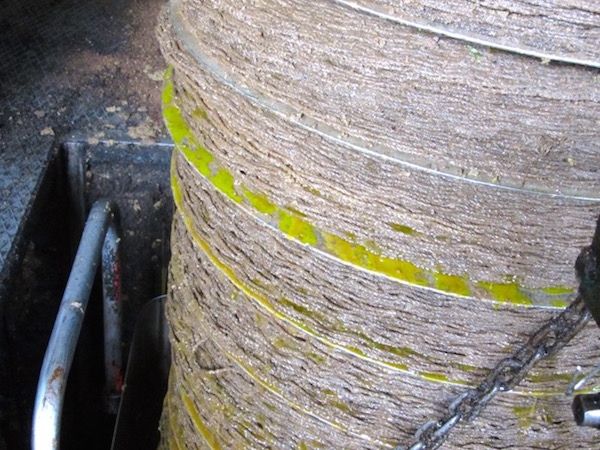
As Elias showed us, his is a traditional press adapted to the highest modern standards. The washery is separate from the machinery to reduce the amount of water entering with the olives, green and black, which are then squashed between two impressive granite millstones. A hundred years ago they would have been turned by horses. The paste is then slathered onto mats piled one by one onto a spool, and we watched as a vivid green substance seeped from them under their weight. In the second stage, the mats enter a hydraulic press, which forces more oil out, the so-called extra virgin cold pressed. In the third stage, the mats are pressed again, with a little water added at room temperature via a centrifugal extractor. In the last stage, the paste is subjected to the extractor a second time.
The first oils, also produced from organically grown olives, are replete with beneficial phenols and have a sumptuous, fruity taste.
I thought of the olives Harilaos and I had labored so hard to pick from our own trees, and the oil we were so proud of. The Gavrio press on Andros replaced its greasy mats and hydraulic spool with a brand new centrifuge last fall, and we suddenly longed for the old method. Elias said that his oils required at least three months to clear, for all the sludge to drop to the bottom of the can or bottle. Ours was transparent at six weeks, not a good sign.
It was time to change the subject. We piled back into the cars and drove to the winery.
Oenoforos (the wine-bearer) is remarkable for being one of the very few vineyards in Greece that faces north. And its owner, Angelos Rouvalis, is one of those people you like on sight: warm, cultivated, funny, kind, and modest, even though he was in the vanguard of the Greek wine revolution and has much he could boast about. Also, as the second man in our entourage, he provided a gentle counterweight to our bevy of gay divorcées (gay in the old sense, of course).
His winery could be called the Balcony over the Gulf of Corinth. Positioned high behind the coast, it overlooks olive green slopes, a flat band of dark green citrus groves, and a strip of cerulean sea backed by cloud-covered mountains. The vineyards lie even higher, 600 meters above sea level.
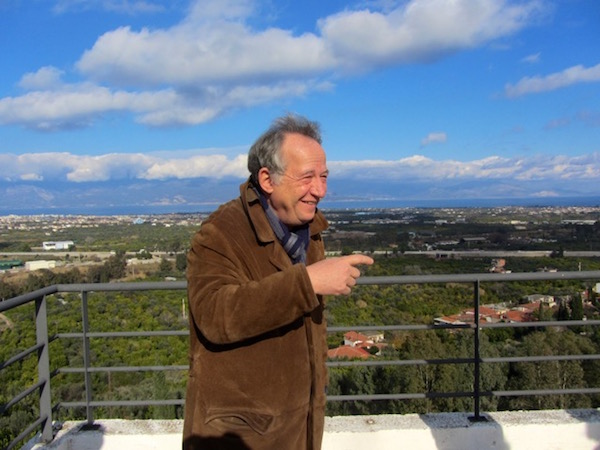
As Angelos told us, “This area was always in the shadow of the currant,” the black gold that the British craved for their quaintly named puddings such as spotted dick. But when, after studying in Bordeaux and working for the Wine Cooperative on Santorini and at the Achaia Clauss winery in Patras, he told his father he wanted to uproot some of the family currants and plant wine grapes instead, the older man had no objection.
Before Angelos showed us the six-story winery, he gave us a geology lesson, taking us back to the days before the Gulf separated the Peloponnese from the rest of mainland Greece. Seismic shifts broke the mainland apart and four rivers flowed in to fill the gap. Now the region, called Aigialia, has its own microclimate created by the continuous interaction of mountains and sea: the sea breeze cools the mountains (which protect the vineyards and coast from the baking heat of Africa) and the mountains cool the sea at night. The vines, mostly whites, flourish, and Oenoforos is best known for Asprolithi, its crisp Roditis, and Mikros Vorias, a fresh and fruity blend of Chardonnay and Sauvignon Blanc.
I have a preference for Greek varieties, so I asked Angelos why he planted these international grapes: after all, in New York restaurants, when you order a white, you preface it by saying ABC, anything but Chardonnay. He looked at me sternly and said, “Don’t be fooled: the terroir is much more important than the type of grape.” But then he added that he is working with both Greek and international varieties and will have some new blends on the market soon.
The winery was impressive but chilly and we would taste his two whites at lunch. The only sign of the country’s deep, ongoing economic crisis was the barrel room, where some of the Ianos line of Oenoforos reds are aged. “We have reduced the amount of aged wine; people can’t afford to buy it,” said Angelos with a shrug.
Lunch, as Gogo had promised, was excellent indeed, in a cozy place with plenty of atmosphere provided by old photos, dark wooden furniture, sprigs of holly, and the owners’ broad smiles. Soon, our glasses filled with Oenoforos wine, we were giggling and exchanging stories with our lively seat mates, and barely taking time out to order. But what a meal: some of the best fresh cheese and spinach pies I’ve ever bitten into, a huge mixed salad, stuffed cabbage leaves generously lapped with egg-lemon sauce, and the pièce de resistance, almost psychedelically divine juicy grilled mushrooms. All for a very modest 15 euros apiece.
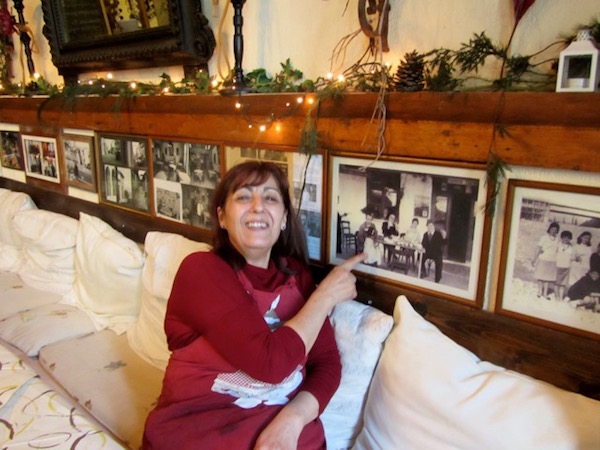
We declined the offer of dessert and moved on to Angelos Rouvalis’s home nearby, where he and his partner lit a fire and gave us coffee, tea, and holiday sweets. I also got a little history lesson as Angelos briefed me on the region’s illustrious past and almost forgotten ancient sites. It seems Aigialia was among the first cities in Greece to establish colonies in Magna Graecia, along with Megara and states on Euboea.
It was well after sunset before we managed to extricate ourselves from the warm house to move on to the final stop on our tour of Aigio, and Harilaos was grumbling about the long day and miles to go before we slept. But Gogo was proven right again. The art exhibition was worth the journey, both for the colorful landscapes and still lifes by native son Panos Feidakis, who died suddenly at 46 in 2003, and the space itself, a splendid 1860s town house with elaborately painted ceilings, only recently restored and open to the public. Erected by a currant magnate, it could be seen as over the top nouveau riche hubris, but it might have fit in well with other Aigio buildings designed by Ernst Ziller, the celebrity architect of those days.
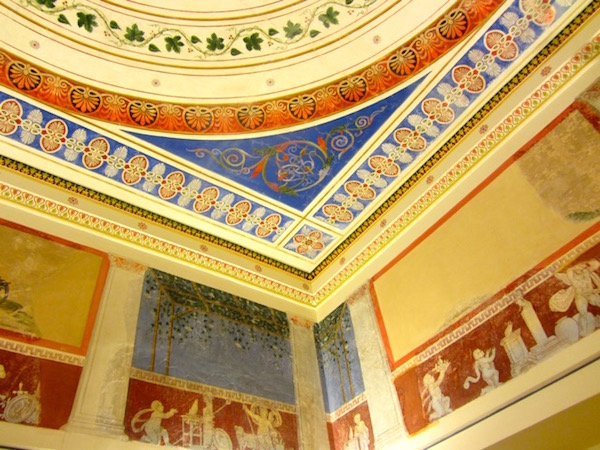
This wonderful gallery, housed in the Panayiotopoulos mansion, is also a reminder that perhaps sleepy, nondescript Aigio deserves closer inspection. We left resolving to return in the spring, to walk through the Oenoforos vineyards at flower time, to seek out the ancient sites, have another meal or two at the Palia Agora Mageirio, and reconnect with our new friends, the gay divorcées.
For twelve hours we had left the “crisis” behind, and revisited the Greece we used to take for granted. It still exists and the only sign of our misfortune was the lamentable condition of the road that leads there.
![]()
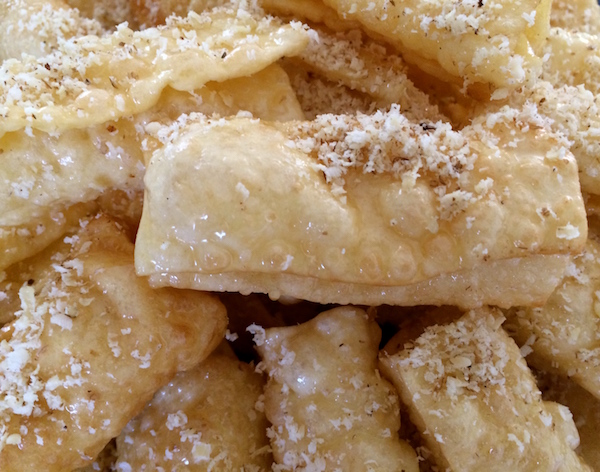
Recipe
Diples (Folded Pastry)
Diples, literally “folded pastry,” comprise a favorite holiday treat throughout Greece. All the sweet shops have stacks of these flattish bands of delicate fried dough in their windows. They should be light as a feather, weighed down only by the chopped nuts and honey sprinkled/drizzled over them. It is impossible to eat them without getting sticky and having crumbs flake all over your front.
Pastry:
420 grams (3 cups) bread flour
60 ml (1/4 cup) raki or brandy
60 ml (1/4 cup) orange juice
2 tablespoons olive oil
1/2 teaspoon salt
2 eggs plus 1 egg white, lightly beaten
120 ml (1/2 cup) soda water
For the syrup:
360 grams (1 1/2 cups) honey
100 grams (1/2 cup) sugar
120 ml (1/2 cup) water
1 cinnamon stick
For the garnish:
150 grams (1 cup) each crushed almonds and walnuts
3 heaping tablespoons sesame seeds
1 teaspoon powdered cinnamon
75 grams (1/2 cup) crushed hazelnuts (optional)
In a large bowl, make a well in the flour and add the raki, juice, oil, salt, and the eggs. Mix in the flour and slowly add the soda water until you have a tough dough. Knead for about 10 minutes so that it is smooth but remains on the tough side. Cover and set aside to rest for about 1 hour while you prepare the area where you’ll roll out the dough, fill a large frying pan with olive oil (about 8 cm/3 inches deep), and combine the ingredients for the crushed nut topping.
Roll out the dough, a little at a time to prevent it drying, so that it is as thin as possible and about the same width overall (easily achieved with a pasta machine, if you have one). Cut the dough in squares about the size of a cocktail napkin (10 cm/4 inches) or into strips 10 cm (4 inches) long and 5 cm (2 inches) wide. If you prefer to work with strips, fold them into bows, triangles and pleats.
Heat the oil until boiling (about 180 C or 350 F) but, as you cook, regulate the heat so the pastries don’t burn, and fry only a few at a time. Lift out and drain on several layers of paper towels, and proceed to the next batch. As the woman who told me this recipe says, it helps to have someone else preparing the squares while you fry. On the other hand, they don’t have to be a specific shape to be good.
Once all the pastry is cooked, make the honey syrup, which should be very thick, taking it off the heat when big bubbles start to form. Dip the pastries one by one into the syrup, let excess drops drain over the saucepan, and then place on a serving platter. Sprinkle them all with the crushed nuts and serve. Makes about 45 pieces. They will keep for about 10 days, but hide them from greedy cats.
Adapted from my cookbook Feasting and Fasting in Crete (Kedros, Athens, 2000).


3 Comments
Will B
What a wonderful excursion! Time spent in the presence of artisans such as these is glorious; being able to savor the fruits of their dedication even more so. And a day with friends such as this – a real gift. And just what I don’t need – a fabulous Greek treat recipe! Yum!
Anita Sullivan
Diana, I’m reading your wonderful piece on a cold, gray January morning, and it really lifts my spirits from our own version of the “crisis” that seems never to end. How I wish we could drink olive oil of that quality, and taste the wine (white being my favorite). I look forward to your return to Aigio in the spring!
Diana
Dear anita and will, thanks so much for your wonderful comments. I wish you could come along with us next time. We definitely need more excursions like this as well as meeting with remarkable dedicated people.